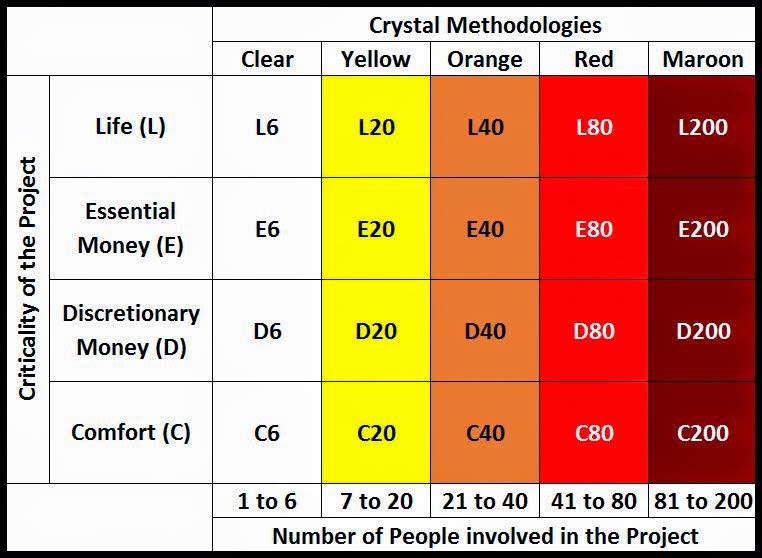Hi
all, Thank you for coming back and reading my blog. I know that it’s been
couple of months since my last post. My apologies for that. I was in to job
trials, facing some health issues but finally could come out of it. Joined new
organisation, completed all medical tests and……… back to blogging with more energy. Let’s get
into our subject. In earlier post, we have discussed about kanban. Let’s
discuss about Crystal methodology in this post.
Crystal is introduced by Alistair
Cockburn as a family of methodologies in 1998. He says that, he developed crystal
methodologies to get rid of software engineering which always questions as "Is
our model accurate?". Think about "Is our product meeting the
customer's needs?" and "Do we have our goals aligned as a team?",
which gives you better product leading to customer satisfaction. Crystal
Methods focuses on communication, with special focus on interaction, community,
people and skills.
 |
| Picture: Alistair Cockburn |
In Cockburn’s words, “Crystal is a family of
human-powered, adaptive, ultra light and stretch-to-fit methodologies sharing a
common genetic code.”
It is mainly developed based on two important things
i.e.
1) teams can streamline their process as they start working
2) Each
project is unique and dynamic which requires unique methods designed for it.
The Crystal Family:
Though it has started in 1998, New members of the
family were defined in 2001 and 2004. Based on the belief that each project is
unique and it may require a slightly tailored set of policies, practices, and
processes in order to meet the project’s unique characteristics. It requires
unique methodology designed for it. Crystal methodologies are categorized
according to the project size (number of people of involved in the project)
that they address and the criticality of the project.
Let’s discuss these factors in detail below
1) Criticality: "Criticality" is defined by
the sentence "A defect in the delivered product could cause loss of "
Comfort (C)
Discretionary Money (D)
Essential Money (E)
Life (L)
For example:
Loss of
comfort & Loss of Life are self-explanatory
Loss of
Discretionary Money (e.g.System errors which have manual fix)
Loss of
Essential Money (e.g.System errors which causes bankruptcy)
2) Project size: number of people working the project.
For example, L40 project is a project which involves up to 40 people developing
a life-critical system. Based on the people working/getting involved in the
project decides it’s size.
Crystal methodologies:
Based on the above listed
factors crystal methodologies have been grouped in to different groups. It uses different colours to denote the “weight” of the
methodology. Darker the colour, heavier the methodology. Crystal methodologies
named in the literature are
Crystal
Clear
Crystal
Yellow
Crystal
Orange
Crystal
Orange Web
Crystal
Red
Crystal
Maroon
Crystal
Blue
and
Crystal Violet
Out of the above crystal methodologies, The
methodologies which were practically used in real projects have been defined
Crystal Orange: Introduced in 1998, targeting C40, D40 and E40
projects.
Crystal Orange Web: Introduced in 2001, targeting web development projects.
Crystal Clear: Introduced in 2004, targeting C6 and D6 projects.
 |
| Picture: Crystal Methodologies-Aerial View |
Crystal Methodologies - Commonality:
There are some common properties (given below) between
different methods of crystal famiy.
1. Frequent delivery
2. Reflective improvement
3. Close or osmotic communication
4. Personal safety
5. Focus
6. Easy access to expert users
7. Automation testing, configuration management
and frequent integration
Let’s discuss about these commonalities and Crystal
clear-process in next post. Would like to conclude this post with some short, meaningful
sentences by Alistair Cockburn. He came up with these from his discussion with
participants
Scrum is about
self-organization
XP is about self-discipline
Crystal is about
self-awareness
Your feedback is important to me; Help me to improve by giving your
feedback. I appreciate it very much! Please feel free to reach out to me @ Linkedin Facebook
Linkedin: http://in.linkedin.com/in/sathrambalaji
Facebook: https://www.facebook.com/sathrambalaji
Twitter: @sathrambalaji
-Balaji Sathram

Thanks
ReplyDelete